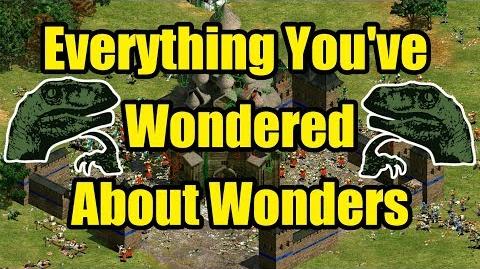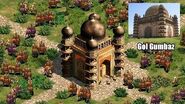| This article is about the building in Age of Empires II. For the building in other games of the series, see Wonder. |
Sound when selecting a Wonder.
| “ | Building a Wonder of the World demonstrates the superiority of your civilization. Constructing a Wonder that stands for a certain period of time is one way to win the game. | ” |
| —Age of Empires II description | ||
The Wonder is a special building in Age of Empires II that becomes available upon reaching the Imperial Age. In specific game modes, the Wonder grants victory if built and defended for 200 years. Wonders cannot be converted.
Each civilization builds a Wonder of historical relevance and unique appearance.
Tactics and placement

Wonders only serve as a victory condition, and as such they must be used only in game modes that allow that kind of victory. When a player starts to build a Wonder, every other player receives a notification with the location of the Wonder so they know where to steer their aggression.
Wonders should be placed in a well-defended area so it is better to first build up a strong fortification composed of Castles, walls, and towers, so basically perform a late-game turtling strategy. In any case, the player must be prepared to be the main focus of all enemy attacks and prepare to defend the Wonder. It is advised to have a huge army to defend against attacking armies, particularly siege units. Since the Wonder takes incredibly long to be built, it is advised to build it with as many Villagers as possible while also leave them near the area once they finish in case the Wonder needs to be repaired. In team games, the support of allies while defending is highly valuable.
It is possible (but costly) to build more than one Wonder so that if one does not stand, other Wonders can stand for the time required to win the game. In The Conquerors, if the player has multiple Wonders and one is destroyed, the timer will reset but still be displayed. Although highly unlikely, if multiple players finished their Wonder at the same time, the player in the highest slot regardless of the color wins once the countdown ends.
A Monument (an unconstructable building) can be found in the Scenario Editor and some campaigns. Its appearance varies being different for each civilization, much like the Wonder, and it has the same icon, although it merely functions as decorative. It has 9999 hit points, making it the bulkiest building in the game.
List of Wonders
The Age of Kings
Britons
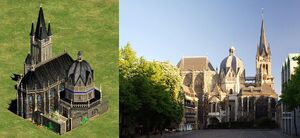
The Aachen Cathedral and its real life counterpart
Wonder: Aachen Cathedral (before the Definitive Edition)
Campaign appearances:
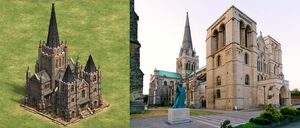
The Chichester Cathedral and its real-life counterpart
Wonder: Chichester Cathedral (in the Definitive Edition)
Byzantines
The Hagia Sofia and its real life counterpart
Wonder: Hagia Sophia
Campaign appearances:
Celts
The Rock of Cashel and its real life counterpart
Wonder: Rock of Cashel
Campaign appearances:
Chinese
The Temple of Heaven and its real life counterpart
Wonder: Temple of Heaven
Campaign appearances:
Franks

The Frankish Wonder and its real-world counterpart
Wonder: St. Vitus Cathedral
Campaign appearances:
Goths
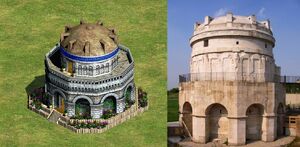
The Theodoric I Mausoleum and its real life counterpart
Wonder: Mausoleum of Theoderic I
Campaign appearances:
Japanese
The Tōdai-ji Temple and its real life counterpart
Wonder: Tōdai-ji
Campaign appearances:
Mongols
The Great Tent of Genghis Khan and a medieval depiction of the tent
Wonder: Great Tent of Genghis Khan
Campaign appearances:
Persians
The Taq-i Kisra Palace and its real life counterpart
Wonder: Taq-i Kisra Palace
Campaign appearances:
Saracens
The Great Mosque of Samara and its real life counterpart
Wonder: Great Mosque of Samarra
Campaign appearances:
Teutons
The Maria Laach Abbey and its real life counterpart
Wonder: Maria Laach Abbey
Campaign appearances:
- Jihad!
- Pax Mongolica (original version)
- The Lombard League
- The Fall of Rome
- Wonder of the World
Turks
The Selimiye Mosque and its real life counterpart
Wonder: Selimiye Mosque
Campaign appearances:
Vikings
The Borgund Stave Church and its real life counterpart
Wonder: Borgund Stave Church
Campaign appearances:
The Conquerors
Aztecs
The Great Pyramid of Tenochtitlan and a render of its real life counterpart
Wonder: Great Pyramid of Tenochtitlan
Campaign appearances:
Huns
The Arch of Constantine and its real life counterpart
Wonder: Arch of Constantine
Koreans
Hwangnyong Temple and a miniature reconstruction of the temple
Wonder: Hwangnyong Temple
Campaign appearances:
Mayans
The Temple of the Great Jaguar at Tikal and its real life counterpart
Wonder: Temple of the Great Jaguar
Campaign appearances:
Spanish
The Torre del Oro and its real life counterpart
Wonder: Torre del Oro
Campaign appearances:
The Forgotten
Incas
The Sun Temple of Machu Pichu and its real life counterpart
Wonder: Temple of the Sun at Macchu Picchu
Campaign appearances:
Indians
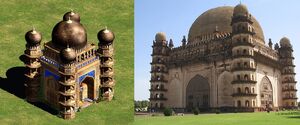
The Gol Gumbaz and its real life counterpart
Wonder: Gol Gumbaz (in The Forgotten and The African Kingdoms)
Brihadeeswarar Temple and its real life counterpart
Wonder: Brihadeeswarar Temple (since Rise of the Rajas)
Campaign appearances:
Italians
The Saint Lawrence Cathedral and its real life counterpart
Wonder: Cathedral of St. Lawrence
Campaign appearances:
Magyars
The Hunyad Castle in The Forgotten and its real-life counterpart
The Hunyad Castle in the Definitive Edition
Wonder: Hunyad Castle
Campaign appearances:
- Pax Mongolica (Definitive Edition)
- The Return of the Dragon
- Saving the Huts
Slavs
The Kizhi Pogost and its real life counterpart
Wonder: Kizhi Church
The African Kingdoms
Berbers
The Hassan Tower and its real life counterpart
Wonder: Hassan Tower
Ethiopians
Bete Amanuel and its real life counterpart
Wonder: Biete Amanuel
Campaign appearances:
- A Fallen Crown
- Welcome Home (Definitive Edition)
Malians
Great Mosque of Djenne and its real life counterpart
Wonder: Great Mosque of Djenné
Campaign appearances:
Portuguese
The Belém Tower and its real life counterpart
Wonder: Belém Tower
Campaign appearances:
Rise of the Rajas
Burmese
Shwezigon Pagoda and its real life counterpart
Wonder: Shwezigon Pagoda
Campaign appearances:
Khmer
Angkor Wat and its real life counterpart
Wonder: Angkor Wat
Campaign appearances:
Malay
Kalasan Temple and its real life counterpart
Wonder: Kalasan Temple
Campaign appearances:
Vietnamese
But Thap Temple and its real life counterpart
Wonder: Bút Tháp Temple
Campaign appearances:
Definitive Edition
Bulgarians
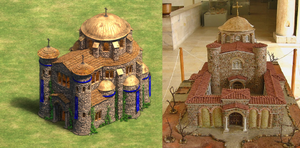
The Preslav Round Church and a miniature reconstruction of the church
Wonder: Preslav Round Church
Campaign appearances:
Cumans

The Sarkel Fortress and an artistic depiction of the fortress
Wonder: Sarkel Fortress
Campaign appearances:
Lithuanians

The Ducal Palace of Trakai Island Castle and its real-life counterpart
Wonder: Ducal Palace of Trakai Island Castle
Campaign appearances:
Tatars
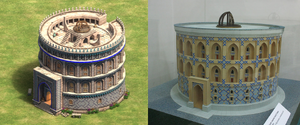
The Ulugh Beg Observatory and a miniature reconstruction of the observatory
Wonder: Ulugh Beg Observatory
Lords of the West
Burgundians
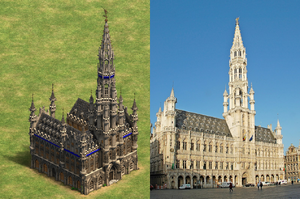
Brussels Town Hall and its real-life counterpart
Wonder: Hôtel de Ville, Brussels
Sicilians
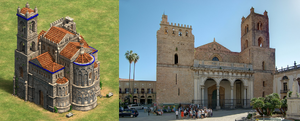
Monreale Cathedral and its real-life counterpart
Wonder: Duomo di Monreale
Campaign appearances:
Further statistics
| Building strengths and weaknesses | |
|---|---|
| Strong vs. | Nothing |
| Weak vs. | Everything except Monks. |
| Upgrades | |
| Hit points | |
| Armor | |
| Line of Sight | |
| Construction speed | |
| Other | |
Civilization bonuses
- Byzantines: Wonders have +40% HP. Town Watch is free.
- Chinese: Technologies that benefit Wonders are 20% cheaper.
- Incas: Wonders cost 15% less stone.
- Italians: Researching Masonry, Architecture, and Treadmill Crane is 33% cheaper.
- Malians: Wonders cost 15% less wood.
- Persians: Researching Town Watch and Town Patrol is 20% faster.
- Portuguese: Technologies that benefit Wonders are researched 30% faster.
- Spanish: Wonders are built 20% faster.
Team bonuses
- A team containing Malians: Researching Masonry, Architecture, and Treadmill Crane is 80% faster.
Changelog
The Age of Kings
- Wonders are always revealed on the map, regardless of victory condition.
- Britons: The Wonder is the Aachen Cathedral.
The Conquerors
- Wonders are only revealed on the map on Standard Victory conditions.
- Wonders are indicated on the minimap as a white spot.
The Forgotten
- Incas and Italians: The Wonder is partially edited from other buildings in the game.
- Indians: The Wonder is the Gol Gumbaz.
- Magyars: The Wonder is a modified, smaller version of the Hunyad Castle.
Rise of the Rajas
- Indians: The Wonder is the Brihadeeswarar Temple. The Gol Gumbaz remains available in the Scenario Editor.
Definitive Edition
- Britons: The Wonder is the Chichester Cathedral. The Aachen Cathedral remains available in the Scenario Editor.
- Incas and Italians: The Wonder has a unique model made from scratch, but it is still based on the same real-life buildings.
- Magyars: The Wonder is a full version of the Hunyad Castle.
Trivia
- The Wonder is the only constructable building that does not have the standard building armor class, along with the Fish Trap.
- The Wonder is the only item in the game to cost three different resources.
- A few Wonders are repurposed as other buildings in the Scenario Editor: The Arch of Constantine in Rome, edited from the Hunnic Wonder; the Gol Gumbaz, previously used as the Indian Wonder, the Mosque, identical in appearance to the Turkish Wonder, the Cathedral, which is a larger version of the former British Wonder (and actually was created first during development), the Temple of Heaven, which is a larger and more decorated version of the Chinese Wonder; and the Palace, which is identical to the Wonder except in the case of the Malians, Ethiopians, and Portuguese, where it resembles previous Wonder models that were later discarded or reworked.
- The icon depicts the Turkish Wonder.
The Age of Kings
- The original British Wonder is located in modern Germany.
- The Frankish Wonder's appearance is anachronistic. St. Vitus Cathedral's Western portal featured in game was finished in late 20s in 20th century. This building is located in Prague - Czech Republic.
- The Turkish Wonder was influenced by the Byzantine Wonder.
The Conquerors
- The Hun Wonder was actually built by the Romans, though it might be a testament of the Huns being one of the barbarian tribes who pushed the Western Roman Empire into decline, as shown by the Huns' loot filling it.
- The Spanish Wonder is usually credited to the Berber Almohad Caliphate, though its ingame appearance includes elements built after its Castilian takeover.
The Forgotten
- The base of the Celt Wonder was slightly altered and reused as a base for the Mediterranean style Castles.
- The top of the Spanish Wonder is also reused for the Italian Wonder.
- The Slav Wonder is anachronistic, as the Kizhi Pogost was not built until the 17th century (outside Age of Empires II's timeframe). A more accurate choice would've been the Moscow Kremlin when it was a limestone citadel, the Dormition Cathedral, or the Ferapontov Monastery.
- Notably, the Russian Mod that preceded The Forgotten and served as basis for the Slavic civilization used a model of St. Basil's Cathedral (near the Kremlin, and often mistaken for it by Westerners), which had been taken from the game Cossacks, and would be a more appropriate choice since St. Basil's was built in 1555-1561 (barely within Age of Empires II's timeframe) to commemorate the Russian conquest of the Tatar khanates of Kazan and Astrakhan.
- It is possible that Kizhi Pogost was chosen as the new Wonder because it resembles St. Basil's but also looks different enough to avoid accusations of plagiarism.
- The presence of the Editor-only Dormition Cathedral in the Definitive Edition may be a result of it being considered as a replacement.
- Similarly, the first Indian mod actually used the Gol Gumbaz's contemporary but much more famous Taj Mahal (1632) as the Indian Wonder.
The African Kingdoms
- The Berber Wonder is actually an incomplete building, being the minaret of an unfinished mosque and has only half of its intended height.
- The Hassan Tower has two finished "twin" minarets in Seville, Spain (Giralda) and Marrakesh, Morocco (Kutubiyya Mosque). Since Giralda was reformed extensively in later centuries, Kutubiyya is the only resembling what a finished Hassan Tower would have looked like.
- The design of the Malian Wonder is anachronistic by necessity. It is based on the current appearance of the Great Mosque of Djenne, but the mosque was rebuilt in the early 20th century. The original mosque would likely have looked different, but no records exist that describe its appearance, so it remains unknown. The architect of the original mosque was from Egypt, so it is possible that it would have been similar to medieval Egyptian mosques in appearance.
- The Ethiopian Wonder in the real world is a monolithic underground rock-cut church, so ideally it should be built by digging the soil, cutting and sculpting an underground rock and digging a passage from above to the church's front door.
Definitive Edition
- The Cuman Wonder was actually built by the Khazars, an unrelated Turkic people, with assistance from the Byzantines, but taken by the Kipchaks from the Kievan Rus' in the 12th century. Although the Wonder having a ruined appearance in-game is likely a reference to this, the list of Cuman AI players also includes some Khazar khans.
- The presence of the Tower of London in the Editor could be due to being considered for new Briton Wonder before the Chichester Cathedral was chosen.
History
| “ | One distinguishing cultural characteristic of the great Middle Age civilizations was architecture. Buildings in Japan, Scandinavia, Britain, Constantinople, and Arabia looked quite different and employed different construction techniques. In many cases, particularly noteworthy buildings stand as icons for the building civilization, marking it for all time as a culture that achieved greatness, if only temporarily. Examples of such Middle Age cultural icons are the Cathedral at Chartres, Charlemagne’s Palace, and the Hagia Sophia at Constantinople. | ” |
| —Age of Empires II manual | ||
Video
Template:Buildings AoE2

